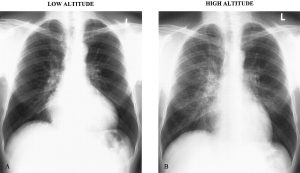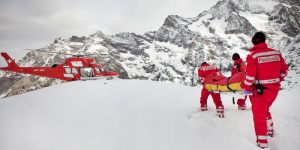
https://www.nationalgeographic.com/adventure/2019/06/mount-everest-highest-weather-station/
What is HAPE?
High Altitude Pulmonary Edema, also known as HAPE, is a condition that occurs at high altitudes typically above 8200 feet. HAPE generally affects people who travel from low elevations to high elevations. This can also happen to people who live at over 8200 feet and travel down to lower elevations then quickly back to over 8200 feet. This is called re-entry HAPE, which has the same affects.
How do you find out you have HAPE?
Symptoms of HAPE may consist of the following: shortness of breath at rest, coughing, weakness or decreased exercise performance and chest tightness or congestion.
Identifying signs of HAPE are as follows: Crackles or wheezing (while breathing) in at least one lung field, central blue skin color, tachypnea (rapid breathing) and tachycardia (rapid heart rate).
While these are all symptoms, they may be subtle or not present at all. The most reliable sign of HAPE is severe fatigue. HAPE generally develops in the first 2-4 days of altitude above 8200 feet. Symptoms usually worsen by the second night. Initial symptoms can be very minuscule but can lead to larger consequences.
 Figure 2: (X-Ray imagine of lungs. Left image showing healthy normal lungs. Right image showing the effects of HAPE.)
Figure 2: (X-Ray imagine of lungs. Left image showing healthy normal lungs. Right image showing the effects of HAPE.)
https://www.ahajournals.org/doi/full/10.1161/01.cir.103.16.2078
What are the risk factors?
There are multiple risk factors that apply to HAPE. This includes sex, genetic factors, prior development of HAPE, ascent rate, cold exposure, peak altitude, intensity of physical exertion, and certain underlying medical conditions (eg, pulmonary hypertension).
How deadly is it?
The severity of HAPE is graded. The grades range from mild to severe. This is determined by the number of symptoms and/or the severity of them. HAPE can be identified by symptoms and/or an X-ray. HAPE can kill you if you do not listen to your body and act upon it in a timely manner. If you see someone with these symptoms, you should act upon it as well, even if they say they are fine.

Figure 3: (Air medical team evacuating an injured patient)
How do you prevent HAPE?
The primary method to prevent HAPE is with a gradual ascent. The Wilderness Medical Society or WMS recommends that above 9,800 feet, climbers do not increase sleeping elevation by more than 1,600 feet a day. Include a rest day every 3-4 days.
How do you treat HAPE?
Treatment consists of different phases. HAPE normally occurs in mountains which are typically not within close proximity of medical help. The first phase is to move the patient down to lower elevation as quickly as possible. Giving oxygen if symptoms don’t go away is the next step. Warming the chest and resting also help alleviate symptoms. If symptoms can’t be resolved with these methods, hospital attention will be needed.